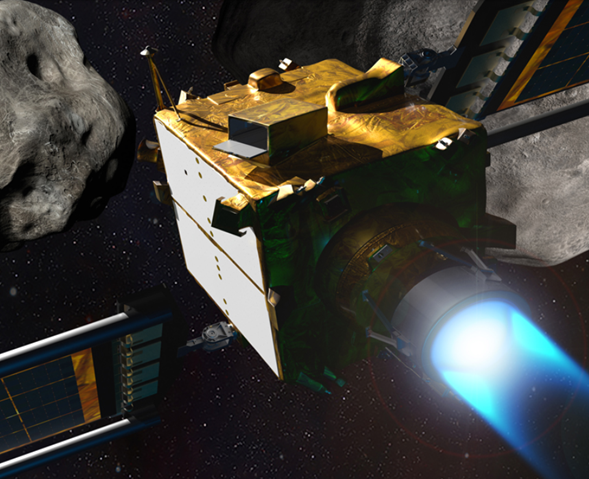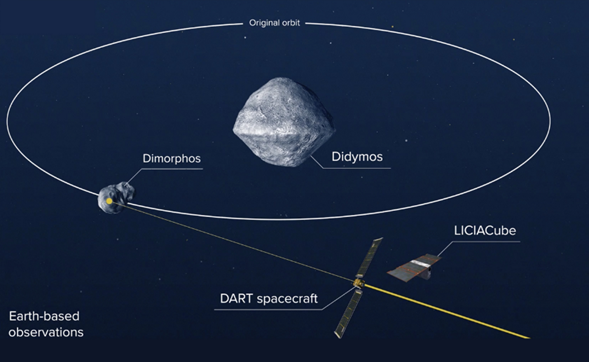NASA has crashed a spacecraft into an asteroid [🇬🇧 / 🇪🇸]
English 🇬🇧
When i came across the news, it seemed like something out of a movie, for example, the well known Armageddon starring Bruce Willis, where a group of drillers are sent to a huge asteroid that has the direction of the earth and this in order to fulfill the mission of splitting the asteroid in two with a bomb that they must bury and prevent it from hitting the earth.
Although NASA's case of crashing an unmanned spacecraft in order to deflect an asteroid (DART Mission) was a reality, it was far from what the movie was.
Español 🇪🇸
Cuando me topé con la noticia, parecía cosa de película, por ejemplo, la bien conocida Armageddon protagonizada por Bruce Willis, donde un grupo de perforadores son enviados a un enorme asteroide que tiene dirección de la tierra y esto con el fin de cumplir la misión de partir en dos al asteroide con una bomba que deben enterrar y evitar que golpeara a la tierra.
Si bien el caso de la NASA de estrellar una nave no tripulada con el fin de desviar un asteroide (Misión DART) fue toda una realidad, estuvo muy lejos de lo que fue la película.

DART
The DART (Double Asteroid Redirect Test) spacecraft with a launch mass of about 610 kilograms and about 500 kilograms prior to the target, has two solar panels that when deployed measure 8.5 meters long each and has a smaller satellite, which would be deployed moments before the target to document everything. It was launched on November 24, 2021 and had a cost of 324 million US dollars and its main objective was its immolation against an asteroid in order to deflect its orbit. This spacecraft belongs to the planetary defense program specifically NEOs (Near Earth Objects). According to NEOs, near-Earth objects come within a range of 30 million miles.
A representation of the distance covered by the NEOs program.
DART
La nave DART (Prueba de Redirección de un Asteroide Doble por sus siglas en inglés) con una masa de lanzamiento de unos 610 Kilogramos y unos 500 Kilográmos previo al objetivo, posee dos paneles solares que al desplegarse miden 8.5 metros de largo cada uno y posee un satélite menor, que se desplegaría momentos antes del objetivo para documentar todo. Fue lanzada el 24 de noviembre de 2021 y tuvo un coste de 324 millones de dólares estadounidenses y su principal objetivo fue su inmolación contra un asteroide con el fin de desviar la órbita de este. Esta nave pertenece al programa de defensa planetaria específicamente a la NEOs (Objetos cercanos a la tierra por sus siglas en inglés). Según NEOs objetos cercanos a la tierra entran en un rango de 30 millones de millas.
Una representación de la distancia que cubre el programa NEOs

Área cubierta por NEOs, Area covered by NEOs - Tierra, Earth - Diámetro del Sol, Sun Diameter - Diámetro de la Tierra, Earth Diameter - Dimorphos (asteroide objetivo) a 6835083 Millas, Dimorphos (target asteroid) at 6835083 Miles
Image is not to scale
The distance covered by the NEOs program in a straight line represents the equivalent of about 3789 earths or about 34 times our sun and the volume covered is approximately 1.130976e+23 cubic miles. The purple dot represents the distance at which the impact between DART and the asteroid Dimorphos occurred.
Some facts about Dimorphos
The asteroid Dimorphos (which has two forms in Greek) is a satellite of the binary asteroid system Didymos. This means that Dimorphos is traveling and rotating around Didymos (which is the larger asteroid). Dimorphos has a diameter of about 160 meters while its traveling companion Didymos is 780 meters in diameter.
This asteroid was perfect for the experiment, because it was traveling in the zone of near-Earth objects and the orbit it follows does not represent any kind of danger to the Earth.
Because of the proximity of the object, instruments on Earth can measure the variations in the brightness of the binary system more accurately. Its proximity allows for better observations.
La imagen no está a escala
La distancia que cubre el programa NEOs en línear recta representa lo que equivale a unas 3789 tierras o unos 34 veces nuestro sol y el volumen que cubre es aproximadamente de unas 1,130976e+23 Millas cúbicas. El punto violeta representa la distancia a la que hubo el impacto entre DART y el asteroide Dimorphos.
Algunos datos sobre Dimorphos
El asteroide Dimorphos (que tiene dos formas en griego) es una satélite del sistema de asteroide binario Didymos. Esto quiere decir que Dimorphos va viajando y rotando alrededor de Didymos (que es el asteroide más grande). Dimorphos tiene un diámetro de unos 160 metros en cambio su compañero de viaje Didymos mide 780 metros de diámetro.
Este asteroide era perfecto para el experimento, porque viajaba en la zona de objetos cercanos a la tierra y la órbita que este sigue no representa ningún tipo de peligro para la tierra.
Por la cercanía del objeto, los instrumentos de la tierra pueden medir las variaciones en el brillo del sistema binario de una manera más exacta. Su cercanía, permite mejores observaciones.

Original Orbit, Órbita original - DART spacecraft, Nave espacial DART - Earth-based observations, Observaciones desde la Tierra
The Collision
Dart collided with Dimorphos at a speed of about 21600 Kilometers / hour at about 11000000 Kilometers (6835083 Miles) from the earth. It is not expected to deflect the asteroid's trajectory by a large angle, so my concern that the object could change orbit drastically and become a hazard is dispelled.
La Colisión
Dart colisionó con Dimorphos a una velocidad de unos 21600 Kilómetros / hora a unas 11000000 Kilómetros (6835083 Millas) de la tierra. No se espera desviar un gran ángulo la trayectoria del asteroide, así que mi preocupación de que el objeto pudiera cambiar de órbita drásticamente y llegar a representar un peligro se desvanece.

In fact, what they want to do is to change the rotation period of Dimorphos in the asteroid binary system. As I mentioned Dimorphos has a rotation around Didymos, its orbit is about 1 kilometer in diameter and has a period of 11.92 hours. NASA estimates to reduce this period by about 10 minutes. So with the collision they "should reduce the velocity of the object by perhaps 1 centimeter / second as explained by astronomer Andy Rivkin, one of the leaders of the mission"c.
You can see how the mission ended in the following video
De hecho, lo que quieren hacer es cambiar el período de rotación de Dimorphos en el sistema binario de asteroide. Como mencioné Dimorphos tiene una rotación alrededor de Didymos, su órbita es de aproximadamente 1 Kilómetro de diámetro y posee un período de 11,92 horas. La NASA calcula reducir este período en unos 10 minutos aproximadamente. De manera que con la colisión "debe reducir la velocidad del objeto en quizás 1 centímetro / segundo según la declaración del astrónomo Andy Rivkin, uno de los líderes de la misión"c.
Puedes ver los como finalizó la misión en el siguiente video
[Source / Fuente](Video de https://www.youtube.com/c/NASA)
You can start watching the climax of the mission from 1:03:50 / Puedes empezar a ver el momento culminante de la misión desde 1:03:50.
Consequences
NASA expects to observe a change in the orbit of Dimorphos and they will do this by measuring variations in the brightness of the asteroid system. All the information will be collected by multiple satellites and telescopes "the DART research team will compare the results of DART's kinetic impact with Dimorphos with very detailed computer simulations of kinetic impacts on asteroids. This will evaluate the effectiveness of this mitigation approach and assess how best to apply it to future planetary defense scenarios"c.
This will be the first human attempt to fight against this force of nature that could become catastrophic. Let's remember that the earth has always been hit by meteorites and asteroids, some become very insignificant so much so that they evaporate in the earth's atmosphere and never reach the earth, but there are others that can destroy the entire ecosystem, for example, the one that hit 66 million years ago in the Yucatan Peninsula (Mexico) that extinguished the dinosaurs and is currently known as the Chicxulub Meteorite.
If the experiment is a success and generates the desired results. This use of technology to avoid a potential collision with the Earth will not go unnoticed. It will surely be one of the most considered options. The correct collision, and if the expected orbital displacement of Dimorphos occurs, remains strong evidence that the fundamentals of physics are on an excellent path.
This opens the doors to science for new research programs. I consider it very important that although it is an experiment, it can be a great opportunity to unite us more as a species to solve a possible problem that we all would have in common and in general to unite us more..
Bonus fact:
Did you know that the earth has its own natural defense against meteors and asteroids?
The universe is so big and vast that even after so many years since its beginnings there are still objects that meet and collide, some are destroyed into millions of pieces, others become one and in the constant collisions new trajectories are generated and so the cycle continues.
The earth has been incredibly lucky to have a neighbor like Jupiter that because of its incredible size and mass makes it a perfect magnet for meteors. So thank you Jupiter
Consecuencias
La NASA espera observar un cambio en la órbita de Dimorphos y esto lo harán midiendo las variaciones del brillo del sistema de asteroides. Toda la información será recopilada por múltiples satélites y telescopios “el equipo de investigación de DART comparará los resultados del impacto cinético de DART con Dimorphos con simulaciones informáticas muy detalladas de impactos cinéticos en asteroides. De este modo, se evaluará la eficacia de este enfoque de mitigación y se valorará la mejor manera de aplicarlo a futuros escenarios de defensa planetaria”c.
Este será el primer intento del humano de luchar contra esta fuerza de la naturaleza que pudiera llegar a ser catastrófica. Recordemos que la tierra siempre ha sido alcanzada por meteoritos y asteroides, algunos llegan a ser muy insignificantes tanto así que se evaporan en la atmósfera terrestre y nunca alcanzan a tocar tierra, pero hay otros que pueden destruir todo el ecosistema, por ejemplo, el que impactó hace 66 millones de años en la península de Yucatán (México) que extinguió a los dinosaurios y que actualmente recibe el nombre de Meteorito de Chicxulub.
Si el experimento es un éxito y genera los resultados deseados. Este empleo de la tecnología para evitar una potencial colisión con la tierra, no pasará desapercibida. Seguramente será una de las opciones más consideradas. La correcta colisión y si se suscita el esperado desplazamiento orbital de Dimorphos, siguen siendo una contundente prueba de que los fundamentos de la física están por un excelente camino.
Esto abre las puertas a la ciencia para nuevos programas de investigación. Considero muy importante que aunque es un experimento, puede ser una gran oportunidad de unirnos más como especie en pro de solucionar un posible problema que todos tendríamos en común y en general unirnos más.
Dato extra:
¿Sabías que la tierra tiene su propia defensa natural contra meteoritos y asteroides?
El universo es tan grande y basto que aún pasado tantos años desde sus inicios aún hay objetos que se encuentran y colisionan, algunos se destruyen en millones de pedazos, otros se vuelven uno y en las constantes colisiones nuevas trayectorias se generan y así el ciclo continúa.
La tierra ha tenido una increíble suerte por tener a un vecino como Júpiter que por su increíble tamaño y masa lo hace un imán perfecto para los meteoros. Así que gracias Júpiter


Enlaces de ayuda todos en español
https://www.bbc.com/mundo/noticias-53215459
https://es.ara.cat/sociedad/sido-impacto-nasa-asteroide-dimorphos_1_4501449.html
https://www.nasa.gov/planetarydefense/dart/dart-news
https://www.nasa.gov/specials/pdco/index.html
https://cnnespanol.cnn.com/2022/09/26/dart-nasa-estrella-asteroide-trax/
Help links all in Spanish
https://www.bbc.com/mundo/noticias-53215459
https://es.ara.cat/sociedad/sido-impacto-nasa-asteroide-dimorphos_1_4501449.html
https://www.nasa.gov/planetarydefense/dart/dart-news
https://www.nasa.gov/specials/pdco/index.html
https://cnnespanol.cnn.com/2022/09/26/dart-nasa-estrella-asteroide-trax/
https://twitter.com/FelQuin/status/1574911885325074433
The rewards earned on this comment will go directly to the people( @flquin ) sharing the post on Twitter as long as they are registered with @poshtoken. Sign up at https://hiveposh.com.
Thanks for your contribution to the STEMsocial community. Feel free to join us on discord to get to know the rest of us!
Please consider delegating to the @stemsocial account (85% of the curation rewards are returned).
You may also include @stemsocial as a beneficiary of the rewards of this post to get a stronger support.
Thank you very much for your support.
At the moment it does not let me mock the beneficiaries. For a next post i will modify it.
It is a great project! Also the curiosity about Jupiter was cool!

!1UP
Yes, this project is very ambitious and it is really worth following its evolution.
Thank you very much for your support and for the 1Up.
!PIZZA
You have received a 1UP from @gwajnberg!
@stem-curator, @vyb-curator, @pob-curator
And they will bring !PIZZA 🍕.
Learn more about our delegation service to earn daily rewards. Join the Cartel on Discord.
PIZZA Holders sent $PIZZA tips in this post's comments:
@flquin(1/5) tipped @gwajnberg (x1)
Please vote for pizza.witness!
Congratulations @flquin! You have completed the following achievement on the Hive blockchain and have been rewarded with new badge(s):
Your next target is to reach 3250 upvotes.
You can view your badges on your board and compare yourself to others in the Ranking
If you no longer want to receive notifications, reply to this comment with the word
STOPCheck out the last post from @hivebuzz: